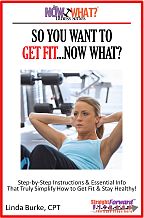Buy "The Now What? eBooks" Here! Or go to Smashwords for misc. formats.
The Now What Fitness Series lays out the foundation of fitness in a concise and simplified manner, making for a collection of books that help the reader truly comprehend how to improve one's health and well-being from A to Z. I've broken fitness down into comprehensive concepts, giving anybody who truly wants to change their health and their lives in profound ways, the step-by-step tools and knowledge to do so.
How do you know your true Max Heart Rate?
As previously discussed, 220 minus your age is a very flawed way to find your max heart rate. I think the more worthy quest is to find your desired target heart rate.
My advice as a fitness professional is use the Karvonen or HRR method for figuring your personal THR (target heart rate) and experiment with other strategies for finding your max heart rate and desired target heart rate, because everybody's is different. It also depends on your level of fitness, physical limitations, etc. Use a combination of HRR (heart rate reserve), the RPE (ratings of perceived exertion), and common sense when exercising and you should be able to find "your" best training zone.
NOTE: If
you are in the habit of trusting the built-in heart rate monitor on your
favorite piece of cardio equipment, DON'T! Many times these are inaccurate and
should not be relied upon for monitoring your intensity.
In summary, you
will want to check your pulse every so often while exercising to get your heart
rate into your desired HRR range and then try to assess on a scale of 1-10 how
hard you are working and alter your intensity accordingly, trying to stay in
what you think is "your" zone.
CHECKING YOUR HEART RATE
To check your heart rate you can find your pulse in 2 different
locations.
1) The carotid artery on the side of your neck as my friend, Rachel, is so
graciously showing here:

2) Or at your radial artery
on your wrist at the base of your thumb, as she shows below:

Put your first 2 fingers over your pulse and
count the number of beats within a 10-second period. Multiply this number by 6,
and you will have the number of heartbeats in a minute. For example, if you
counted your pulse to be 20 during the 10-second pulse count, your heart rate
would be 120 beats per minute.
THE TALK TEST
Or…if you aren’t motivated by numbers, you can
always check your intensity level by using the talk test. This
method entails maintaining an intensity of exercise at which conversation is
comfortable. If breathing is labored and difficult, the intensity is too great.
RATINGS OF PERCEIVED EXERTION
Yet another way is to use ratings of
perceived exertion or RPE. The easiest way to do this
is use the 1-10 scale, as shown in the chart below.
| Level | Feeling |
| 1 | Really easy. |
| 2 | Easy. |
| 3 | Moderate. Talking is becoming difficult. |
| 4 | Sort of hard. |
| 5-6 | Hard. Open mouth breathing. Rather not talk. |
| 7-8 | Really hard. Can say two words. |
| 9 | Extremely hard. Conversation requires maximum effort. |
| 10 | Full-out effort. No conversation is possible. |
HEART RATE MONITORS
Let's not forget to mention the heart rate monitor. This is the easiest method since you don't have to find your pulse or do any math or counting. But, let's face it. Not many of us want to strap on a monitor around our chest, arm, or wrist every time we go for a cardio workout. However, it is a very reliable option, so I thought I'd better mention it.
And one more thing! Be careful not to get into the habit of strolling comfortably
along on the treadmill for hours, never challenging your heart barely past the
napping stage. I see it all the time in the gym. Come on peeps! We gotta move
it to lose it! They don't call it "progressive" training for nothing.
Most importantly, get up and go do your cardio
on a regular basis and make sure you are getting into your what?...that's
right...all together now...YOUR TARGET HEART RATE ZONE!! Yay...and
the crowd goes wild!
Back from Heart Rate Max to Target Heart Rate
Back from Heart Rate Max to Cardiovascular Fitness
Back to Straightforward Fitness Home
